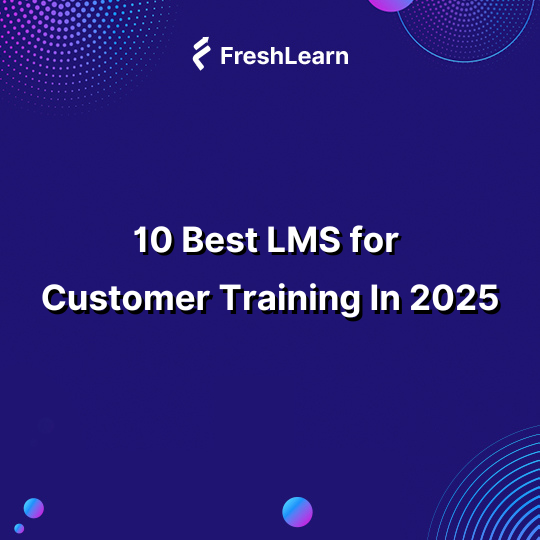
10 Best LMS for Customer Training In 2025
Customer success no longer ends at the point of purchase. In 2025, the real differentiator is how effectively you enable customers to realize value from your product.
I experienced this first-hand in mid-2024 when I purchased a project management tool as a freelancer. The platform itself was powerful, but the learning curve was steep. With no clear training resources, I wasted hours piecing together forum threads and generic PDFs. Eventually, I abandoned features that could have made my workflow far more efficient simply because I didn’t know how to use them.
Without structured training, even the most innovative solution risks being underutilized or worse, abandoned.
But you needn’t worry.
It's good for you that your product could benefit from the best LMS for customer training, which I have listed below.
Signs your business needs an LMS for customer training
i) Your customer support team is overwhelmed with repetitive questions: The team keeps getting the same questions over and over, leaving them stretched thin and struggling to keep up. It traps them in a loop, instead of having time to handle anything beyond the basics.
ii) Customer onboarding is inconsistent and time-consuming: One customer gets a detailed walkthrough, another receives a rushed email, and a third gets… nothing at all. Sound familiar? Without a structured customer training system, onboarding turns into a game of chance.
iii) Customers are churning early without seeing the full value of your product: They sign up, explore for a bit, and leave before experiencing the features that truly make your product shine. It feels like they gave up too soon, but really, they just never got the right guidance to see what’s possible.
iv) You lack a scalable way to train a growing customer base across different regions: It’s easy to keep things personal when you only have a handful of customers. But once your user base spans countries and time zones, one-on-one calls aren’t realistic anymore. Training needs to scale as fast as your growth does.
v) You have no way to track if customers have completed training or understood key features: You send out guides and tutorials, but you’re left wondering, did they even look at them? Without visibility into progress, you’re guessing at what customers know (and don’t know), which makes supporting them that much harder.
So, what does a customer training LMS solve?
- Slash support tickets by equipping customers to self-serve.
- Free your support team for complex issues
- Create a scalable and perfectly consistent onboarding experience.
- Increase product adoption and reduce churn.
How to choose the right LMS for customer training: A step-by-step guide
Knowing all that, the next obvious question is: how do you actually choose the right customer training software? With so many platforms out there, each claiming to be the best, it’s easy to feel stuck.
Here, a step-by-step approach helps cut through the noise and makes the decision a lot less challenging.
Step 1: Understand the different types of LMS
Not all LMSs are created equal. Knowing the types can help you self-segment and narrow down your options:
- SaaS / Cloud LMS: Hosted online, updated automatically, and accessible from anywhere. Ideal if you want low setup hassle and scalability.
- Open-Source LMS: Highly customizable, but requires technical resources to set up and maintain. Best if you need complete control.
- WordPress Plugin-Based LMS: Perfect for small businesses already using WordPress. Quick to integrate, but may have limitations for advanced features.
Step 2: Define your core needs (The 5 ‘S’s)
Before comparing platforms, get clear on your priorities using this framework:
- Scale: How many customers will you train now, and how many in two years? Ensure the LMS can grow with you.
- Simplicity: How easy does it need to be for your team to create content and for customers to use it? Complicated systems can slow adoption.
- Scope: Do you just need basic courses, or do you want advanced features like certifications, live sessions, and gamification?
- Stack: Does the LMS need to integrate with your CRM (like Salesforce), support tools (like Zendesk), or customer success platforms?
- Spend: What is your total budget, including setup fees and potential add-ons? Sorting it out early means no hidden headaches later.
Step 3: Key features to evaluate
Here’s a checklist of must-have features, with benefits explained so you know why they matter:
- Intuitive course builder: Let your team create content quickly without relying on developers or technical experts.
- White-labeling and branding: Offers a smooth brand experience for your customers, so the LMS feels like part of your product.
- Analytics and reporting: Helps you track customer progress, identify those who may be struggling, and prove the ROI of your training efforts.
- Integrations: Ensures your LMS works with your existing systems, creating a single source for customer data.
- Automation & AI features: Automates reminders, personalizes learning paths, and even helps generate content, saving your team time and effort.
- Branded mobile app: Allows customers to learn anytime, anywhere, improving engagement and adoption.
A comparative review of the 10 best customer training LMS platforms
A comparative review of the 10 best customer training LMS platforms.
1. Absorb LMS
User rating: 4.6/5
Best for: organizations that want to manage large-scale training programs across different audiences. It works for companies training both employees and customers, especially when advanced analytics are a priority.

Absorb LMS is a cloud-based learning management system designed for businesses that need to deliver training to employees, customers, or partners at scale. It emphasizes ease of use for both administrators and learners, while still offering advanced features like automation, analytics, and integrations.
With support for mobile learning, multilingual interfaces, and customization, Absorb adapts to organizations that want flexible, branded training experiences.
Key features
- Personalized learning paths & self-paced access: Absorb LMS supports self-paced learning, letting customers go through training at a speed that works for them. You can tailor learning paths by role or experience level, so new users don’t get lost while advanced users keep progressing without restrictions.
- Flexible, custom-branded learner portals: You can create separate, secure portals or “departments” for different customer segments, and fully customize the look — logos, colors, even add tags, so the training feels like part of your product.
- E-signatures: Absorb LMS captures eSignatures to confirm course completions, policy acknowledgments, or compliance requirements. The system securely records signatures with timestamps and login credentials, giving organizations reliable, auditable training records.
- Strong integrations & APIs: Absorb LMS integrates with CRMs (Salesforce, etc.), supports single sign-on (SSO), has RESTful APIs, and provides data synchronization to keep customer training, support, and product data aligned.
- External training & certification tracking: You can track training done outside the LMS (external training) via templates, and manage certifications and external qualifications as part of your training ecosystem.
Pricing
Absorb LMS offers a free trial and provides custom pricing based on the no. of learners you have.
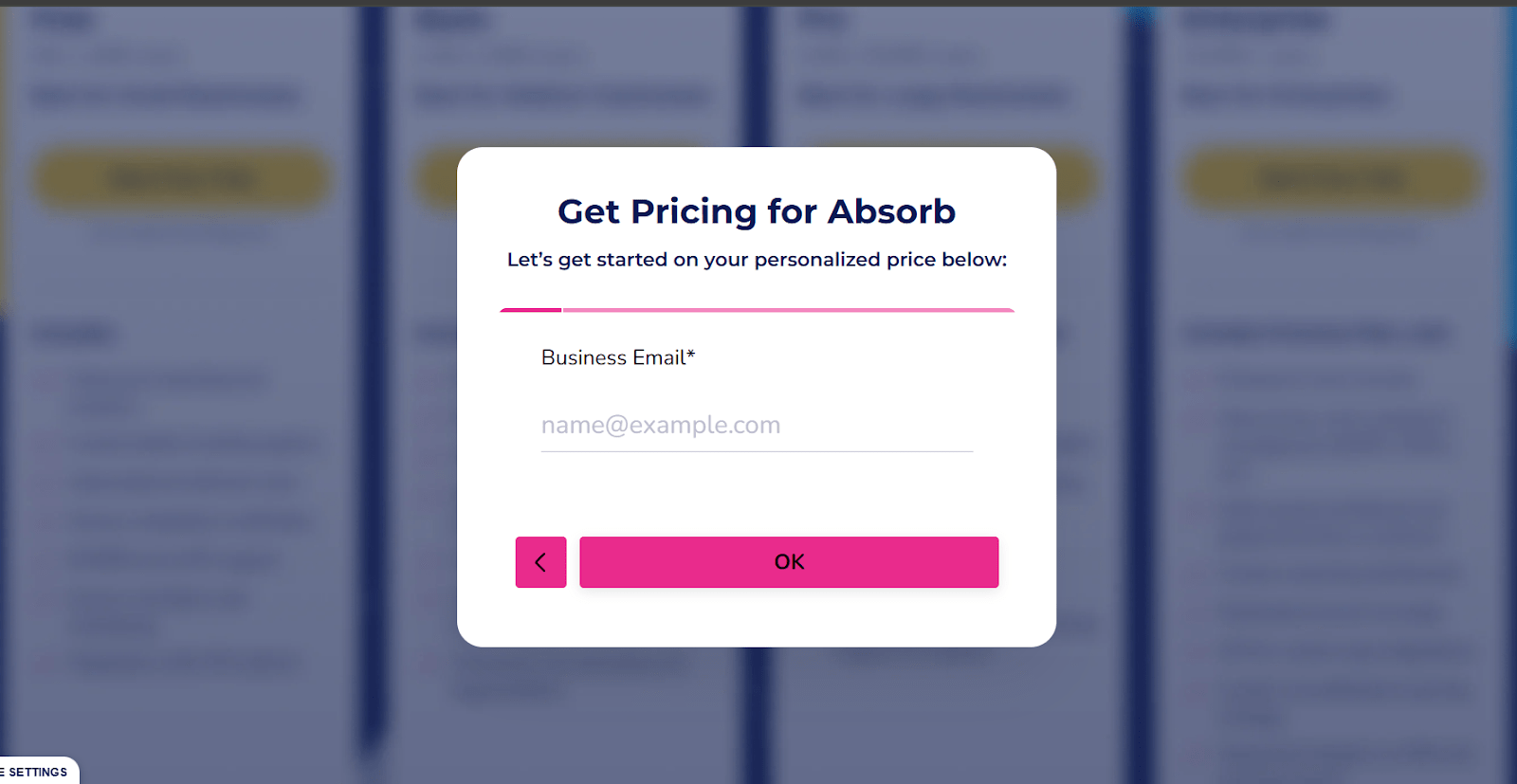
2. Skilljar by GainSight
User rating: 4.6/5
Best for: businesses that need to deliver structured training to external audiences like customers and partners. It suits teams that want to guide product adoption through self-paced learning paths and certifications.

Skilljar is a customer education LMS designed to deliver training beyond internal teams. Businesses use it to build courses, organize content into learning paths, and issue certifications that track progress.
The platform supports self-paced learning and on-demand courses, integrates with CRMs and marketing tools, and gives insights through analytics, helping companies guide customers and partners toward successful product adoption.
Key features
- Content syndication: Skilljar lets you share training content directly into a customer’s LMS while keeping control over it. Updates apply automatically, and you still receive analytics. This feature is available on Professional and Enterprise plans.
- External management for training licenses: You can assign and manage training licenses for external teams or partners, making it easier to control access and track usage.
- Strategic insights: The platform benchmarks your program’s performance against other Skilljar customers, helping you compare completion rates, enrollments, and engagement to show the impact of training.
- Data connector: Skilljar gives you direct access to training data in a real-time PostgreSQL database, allowing analysts to combine it with other business data for deeper insights.
- Customizable academy: You can design a branded training academy with flexible layouts, custom domains, and tailored experiences, giving customers a consistent learning environment that reflects your brand.
Pricing
Skilljar provides custom pricing based on the business’s requirements.
3. LearnUpon
User rating: 4.6/5
Best for: Organizations seeking to provide structured training across multiple audiences. Its capabilities support both internal employee development and external customer or partner education initiatives.

LearnUpon is a learning management system (LMS) designed to facilitate training across various audiences, including employees, customers, and partners. The platform offers features such as course creation, learner management, and reporting.
It supports multiple content types, including SCORM and xAPI, and provides tools for tracking learner progress and engagement. LearnUpon also helps create branded portals for different user groups and integrates with various third-party applications to streamline workflows.
Key features
- Tailored learning journeys: Assign courses and onboarding paths automatically based on a learner’s role, needs, or group, ensuring learners access content relevant to their responsibilities.
- Assessments and feedback: Use exams, assignments, knowledge checks, and surveys to monitor learner progress and gather feedback for administrative review.
- Cross-portal course management: Copy, edit, and share courses between portals while controlling licenses, enrollments, and updates from a central version.
- Integrations: LearnUpon connects with CRMs, HR systems, and other business tools. These integrations help sync learner data, streamline reporting, and link training outcomes to business metrics.
- Gamification and leaderboards: The platform lets you apply gamification elements like points, badges, levels, and leaderboards. This helps in tracking learner activity and engagement across courses.
Pricing
LearnUpon provides custom pricing, typically depending on your user base.

4. Litmos
User rating: 4.3/5
Best for: mid-sized to large organizations that need to deliver employee training, compliance courses, and customer or partner education across multiple locations. It fits industries where quick onboarding and standardized learning content are priorities.

Litmos is a cloud-based learning management system that delivers training for employees, customers, and partners in a centralized environment. The platform supports course creation, virtual and in-person instructor-led sessions, compliance tracking, and integration with other business systems such as HR or CRM tools.
It includes mobile compatibility and multilingual capabilities to help organizations provide learning access across regions. It also provides automation features for enrollment and reporting, helping teams scale training while reducing administrative workload.
Key features
- AI/ML-driven assessments: Litmos utilizes AI-powered video assessments to evaluate learners and provide personalized, machine-learning-based feedback.
- Personalized learning environments: The platform supports multiple audiences by allowing custom branding, themes, and connected instances for reseller or OEM customers, with the ability to manage invoices, taxes, and multilingual requirements.
- Monetization options: Organizations can generate revenue by publishing public training course catalogs and offering certifications to external learners. They can also integrate Litmos with CRMs, eCommerce tools such as Shopify, and payment processors to support subscription or per-course payment models.
- Regional and language support: Litmos supports nearly 40 languages. It also provides localization for course content, content libraries, notifications, emails, closed captions, and user settings, including time zones and compliance requirements.
- Learner engagement tools: Built-in gamification features, including leaderboards, badges, points, interactive hotspots, social sharing, and discussion forums, help learners explore content, ask questions, and engage with the platform.
Pricing
Litmos provides a 14-day trial period and has a custom pricing model.
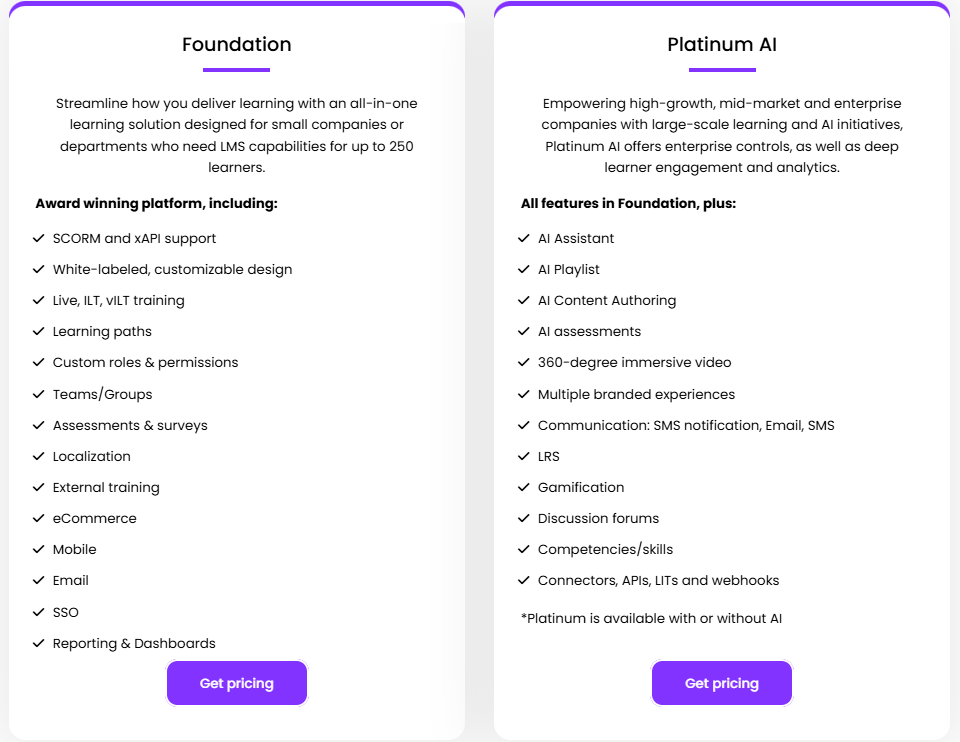
5. Docebo
User rating: 4.3/5
Best for: organizations of medium to large scale that need a configurable, enterprise-grade LMS to support multiple audiences (employees, customers, partners), global deployment, and diverse learning workflows.

Docebo is a cloud-based learning platform built to support both internal and external learning programs. It combines a learning management system (LMS), content authoring, social and informal learning tools (such as peer-sharing and communities), and features like content tagging, assessment generation, and translation.
It supports multiple portals, branding, and eCommerce, allowing organizations to host different learning audiences (employees, customers, partners) in one setup while managing global operations, content localization, and compliance tracking.
Key features
- Social learning: Organizations can enable customer success managers to act as subject matter experts and interact directly with customers within the learning environment.
- Mobile learning: Customers can access training programs, product details, and self-service resources in real time through the Docebo mobile app or a branded version of the app.
- Customer onboarding: New customers can complete onboarding through personalized and self-directed courses, as well as instructor-led and virtual instructor-led training, to reduce the time required to become familiar with products and services.
- Data insights and analytics: Product usage and adoption data help organizations understand customer satisfaction, predict churn risk, and assess how training impacts customer success outcomes.
- Integrations: Docebo supports more than 35 native integrations and connectors, including HRIS, CRM, e-commerce, course authoring tools, and single sign-on. It also gives access to content from the content marketplace in SCORM format.
- Customization and permissions: Administrators can configure multiple degrees of user permissions across the platform and its sub-domains to meet organizational requirements.
Pricing
Docebo offers custom pricing tailored to the features you require.

6. FreshLearn
User rating: 4.7/5
Best for: Small-to-medium businesses that want to launch customer training, workshops, and digital products without heavy technical overhead. It appeals to organizations aiming to monetize their courses, provide branded learner experiences, and scale training with minimal friction.
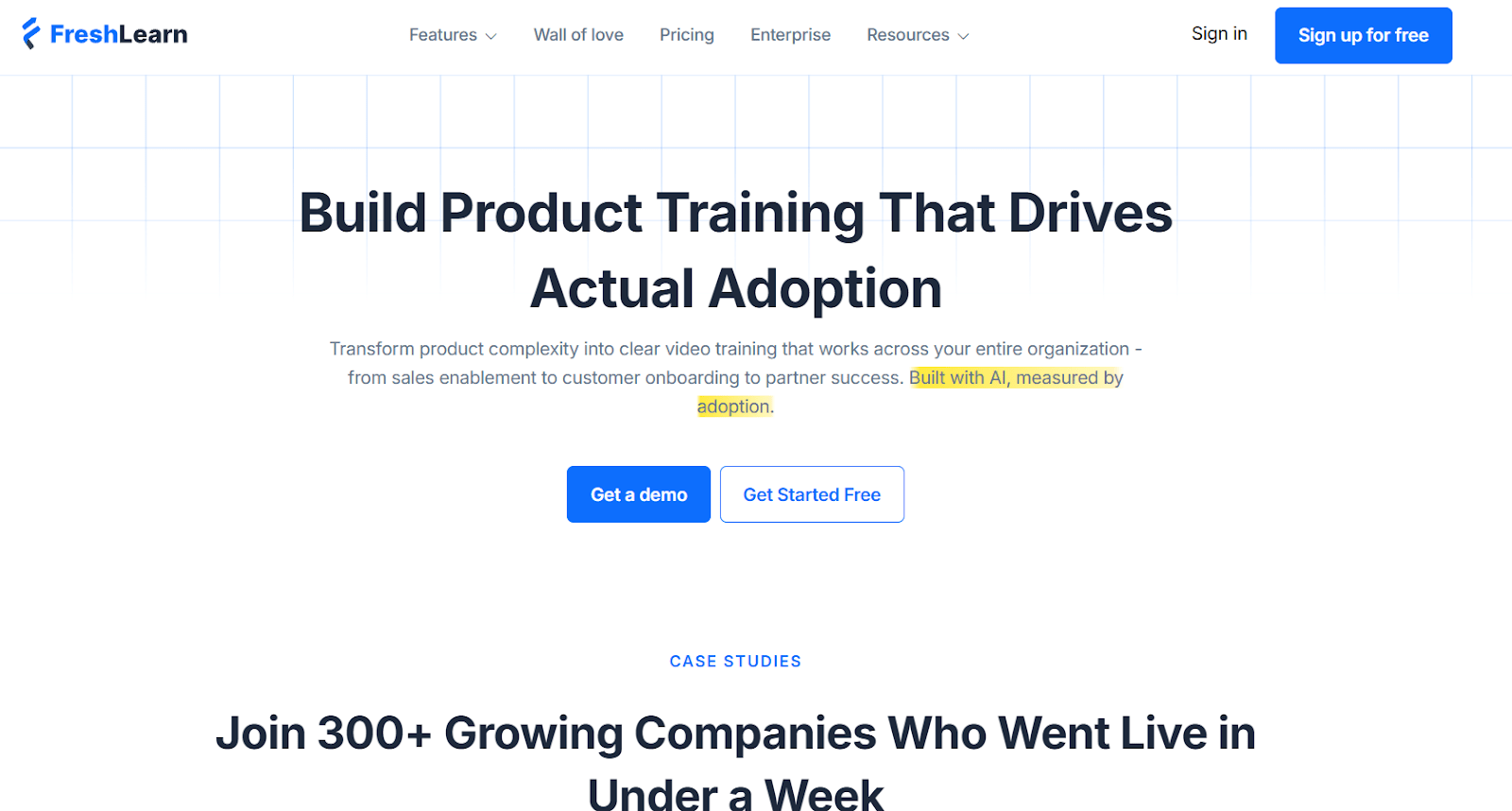
FreshLearn is an all-in-one online LMS platform that combines course creation, marketing, community features, and monetization tools into a single environment. It allows users to build on-demand courses, host live cohorts and workshops, publish e-books and streaming video playlists, and automate content delivery through drip schedules.
Branding and user experience are fully customizable, with features such as white-label mobile apps and custom domains. The platform supports certificates, assignments, assessments, and detailed reporting. Payment integrations (e.g., Stripe, PayPal, Razorpay) and zero platform transaction fees help creators to keep more of their revenue.
FreshLearn also offers built-in marketing tools, affiliate/referral programs, and even a dedicated migration team.
Key features
- AI agents: FreshLearn has AI-powered solutions for various key functionalities, including:
- AI course idea validator: FreshLearn helps you validate course ideas using AI so that you can identify topics with strong demand before building content.
- AI course outline generator: The platform generates complete course outlines with AI, enabling creators to structure lessons and modules effectively.
- AI quiz generator: FreshLearn helps create quizzes automatically through AI, saving time for instructors while ensuring assessments align with course content.
- Testimonials: Businesses can collect and display learner testimonials directly on their website, enhancing credibility and social proof.
- Automations: FreshLearn allows businesses to build personalized journeys for each customer using a drag-and-drop workflow builder. You can design welcome series, sales sequences, freebie deliveries, and more while accessing detailed analytics to track opens, clicks, bounces, and overall engagement.
- Email campaigns: The platform allows creators to design and send targeted email campaigns using its drag-and-drop builder for onboarding, engagement, and re-engagement, strengthening learner communication.
Pricing
FreshLearn offers a 14-day trial period and has the following pricing plan for businesses.
Enterprise: $249/month, $169/month (when paid annually), or $139/month (when paid biennially).

7. TalentLMS
User rating: 4.6/5
Best for: Startups and teams that need to deliver training quickly with low overhead, manage both internal and external users, and scale gradually without heavy initial investment.
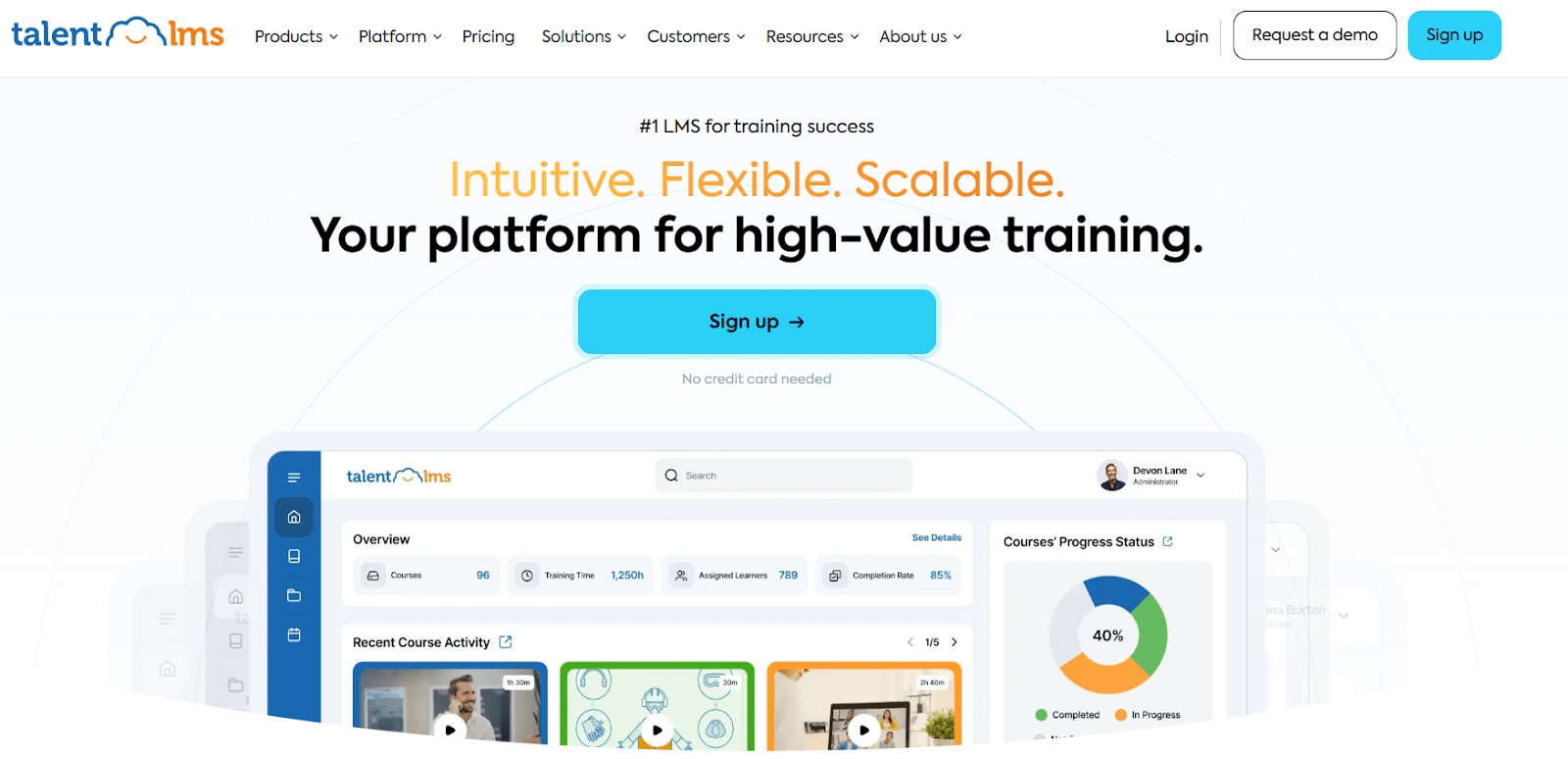
TalentLMS is a cloud-based learning management system built to help organizations deploy training programs that cover self-paced courses, instructor-led sessions, and blended learning models.
It supports standards like SCORM, xAPI, and cmi5, offers built-in AI assistance in content generation and translation, and provides tools such as assessments, surveys, gamification (badges, points, leaderboards), certifications, and reporting.
It includes features for branding, multilingual support, branches or sub-accounts for distinct user groups, mobile access via native apps, and integrations with external tools (payment gateways, video conferencing, CRM, etc.) to support both learning delivery and tracking.
Key features
- Targeted training: Separate customers by product line, region, or any custom category. Divide your training environment into autonomous sub-portals and assign specific users to each portal to offer training that matches their needs.
- Multilingual Support: Localize portals into the languages your users prefer. Adapt settings like time format, date, and timezone. Offer training that feels more accessible to global audiences to improve adoption and engagement.
- Payment integrations: TalentLMS integrates with Stripe, PayPal, and e-commerce platforms like Shopify and WooCommerce to enable secure course purchases, subscriptions, and automatic enrollments.
- Reporting: Reporting tools display training performance through a dynamic dashboard. Administrators can drill down into custom reports to identify problem areas and make data-driven decisions to improve customer satisfaction.
Pricing
TalentLMS has a pricing plan based on the functionalities you require:
- Core: Starting at $149/ month or $119/month (when billed annually). For 1-100 users.
- Grow: Starting at $299/ month or $229/month (when billed annually). For 1-500 users.
- Pro: Starting at $579/ month or $449/month (when billed annually). For 1-1000 users.
- Enterprise: Custom pricing (starts at 1000 users).
- Including TalentLibrary will incur additional costs across plans
- Flexible user limit is available from the pro plan and increases the starting price to $599/month + $6 per additional user.

8. Workramp
User rating: 4.4/5
Best for: Mid-market to enterprise organizations that deliver training for employees, customers, partners, or vendors, and require scalable, centralized learning programs. It fits teams wanting blended learning (live + on-demand) and training analytics across internal and external audiences.
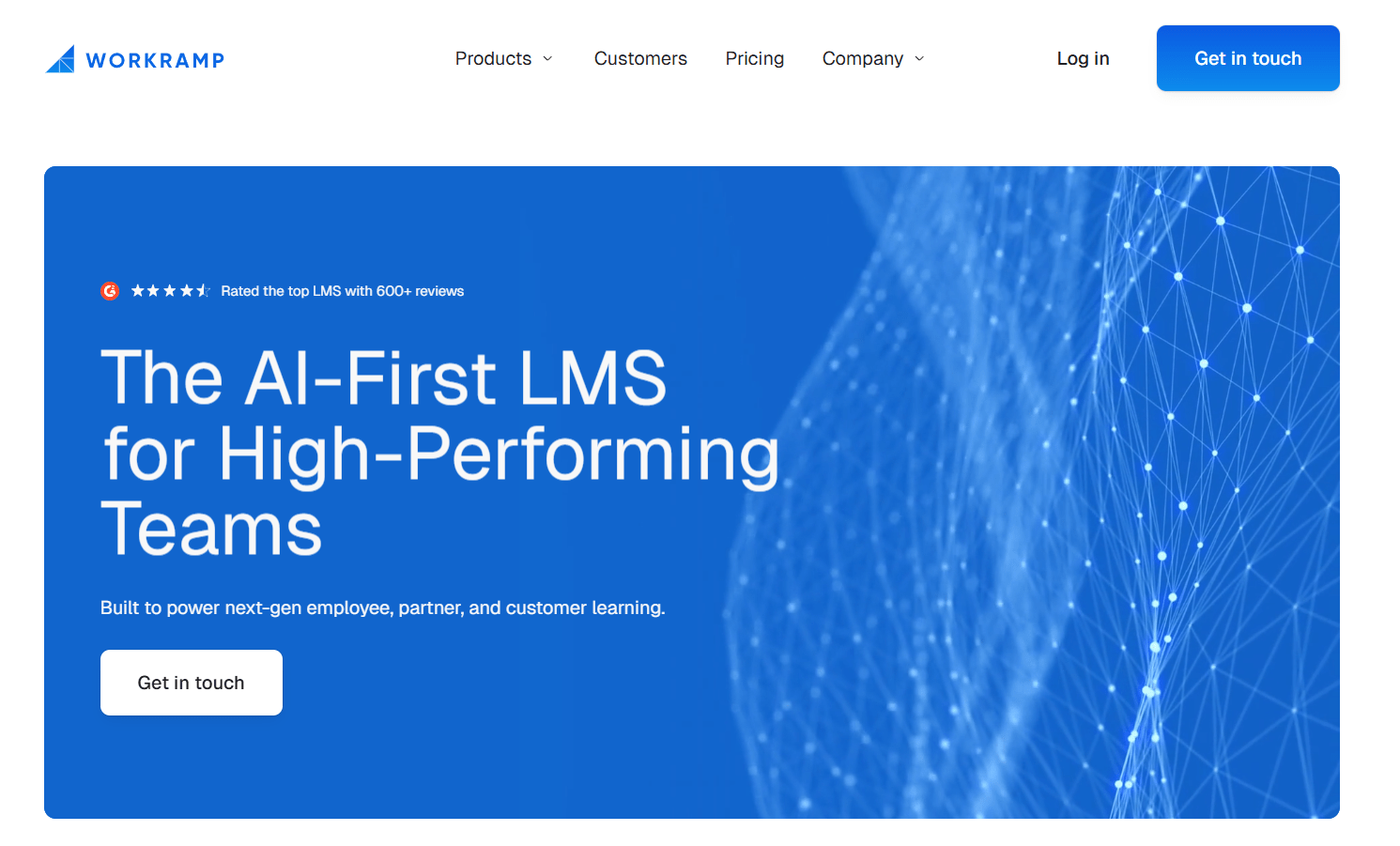
WorkRamp is an AI-first LMS platform built to support employee, customer, and partner learning on a single system. It provides tools for on-demand self-paced courses, instructor-led training, and blended learning, and allows for branded experiences, workflows, and customizable paths.
The system integrates with common enterprise tools (such as Salesforce, Slack, and HRIS systems). It also supports automated enrollment, certifications, and compliance tracking, and offers analytics dashboards and reporting to help training teams measure performance and adjust programs.
Key features
- AI course creation: WorkRamp uses AI tools to help training teams build learning content, events, and resources in multiple formats to improve learner engagement and product knowledge retention.
- Certifications and advocacy: The platform enables organizations to create certifications that customers and partners can share on LinkedIn, helping them showcase skills while encouraging broader engagement.
- Theming and customizations: WorkRamp allows organizations to customize the learning environment with branding, custom domains, and single sign-on (SSO) to maintain consistency with existing systems.
- Customer academy: Teams can create and launch a branded customer academy to deliver onboarding, product training, and certifications while tracking learner engagement and adoption metrics.
- Multi-tenancy and segmentation: The platform supports multi-tenancy and audience segmentation, allowing organizations to tailor the learning experience for different customer or partner groups.
Pricing
Workramp provides custom pricing based on basic requirements and add-ons.
9. 360 learning
User rating: 4.6/5
Best for: Organizations that prioritize collaborative, peer-driven learning workflows, need to scale upskilling and internal expertise from within, and want an LMS that supports employee, partner, and customer training in one system.

360Learning is a learning platform that blends LMS and LXP (learning experience platform) features to enable collaborative learning, knowledge sharing, and skills development across organizations.
Subject matter experts can contribute content; learners can give feedback, comment, and interact, which helps courses evolve over time. The platform supports asynchronous learning, micro-learning content, mobile access, and integrates with systems like HR, Slack, or Microsoft Teams.
Analytics dashboards track learner engagement, content effectiveness, and skill progress to help training teams refine programs.
Key features
- Custom customer academies: Organizations can set up branded customer academies with private groups, custom banners, welcome messages, and URLs for a consistent learner experience.
- User and group management: Administrators can organize customers into groups or sub-groups, use CSV imports or magic-link self-registration, and automate user provisioning.
- E-commerce and course catalog: The platform enables publishing course catalogs for customers and integrates with payment processors to manage paid training programs.
- Reporting and analytics: Built-in dashboards track training usage, completion rates, and learner progress, with tools to identify low engagement or drop-off points.
- Localization support: 360Learning supports multiple languages and allows learners to choose their preferred languages for content and interface.
- Multiple content formats: The system supports video, SCORM/xAPI content, documents, and various assessments such as quizzes, surveys, peer reviews, and screencast demos.
Pricing
360 learning offers a 30-day free trial and has the following pricing plans:
- Team: $8 per registered user per month (limited to 100 users/month)
- Business: Custom pricing.
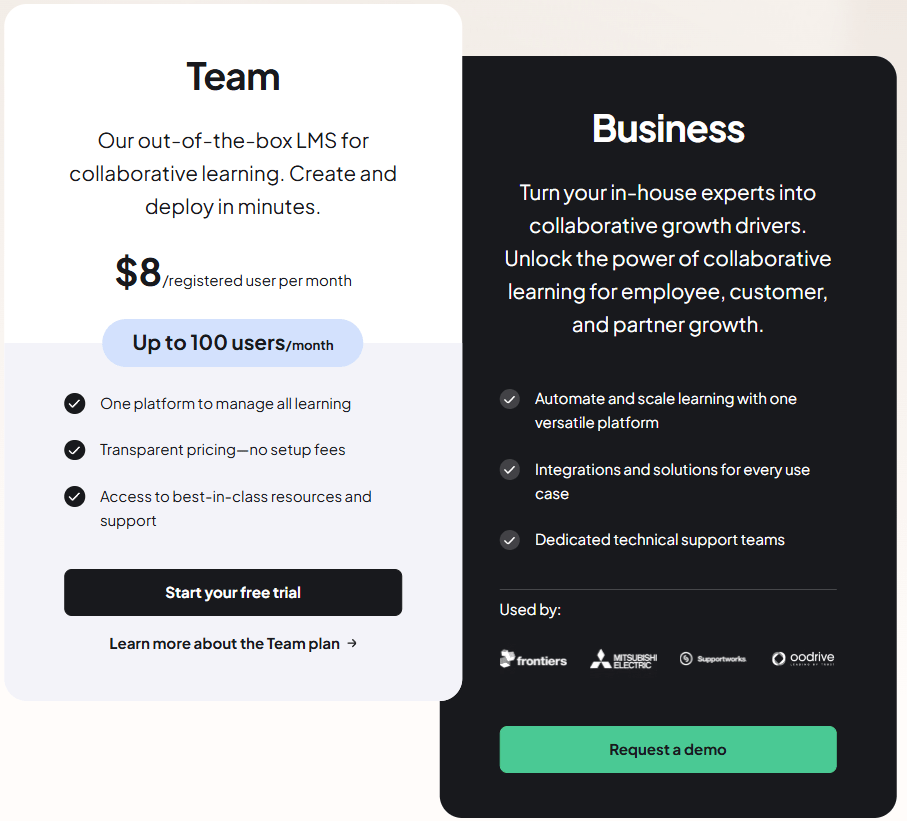
10. iSpring Learn
User rating: 4.6/5
Best for: Organizations that need a stable LMS to deliver training to both internal employees and external learners (such as customers or partners), especially when onboarding, compliance, product training, or microlearning content are priorities.
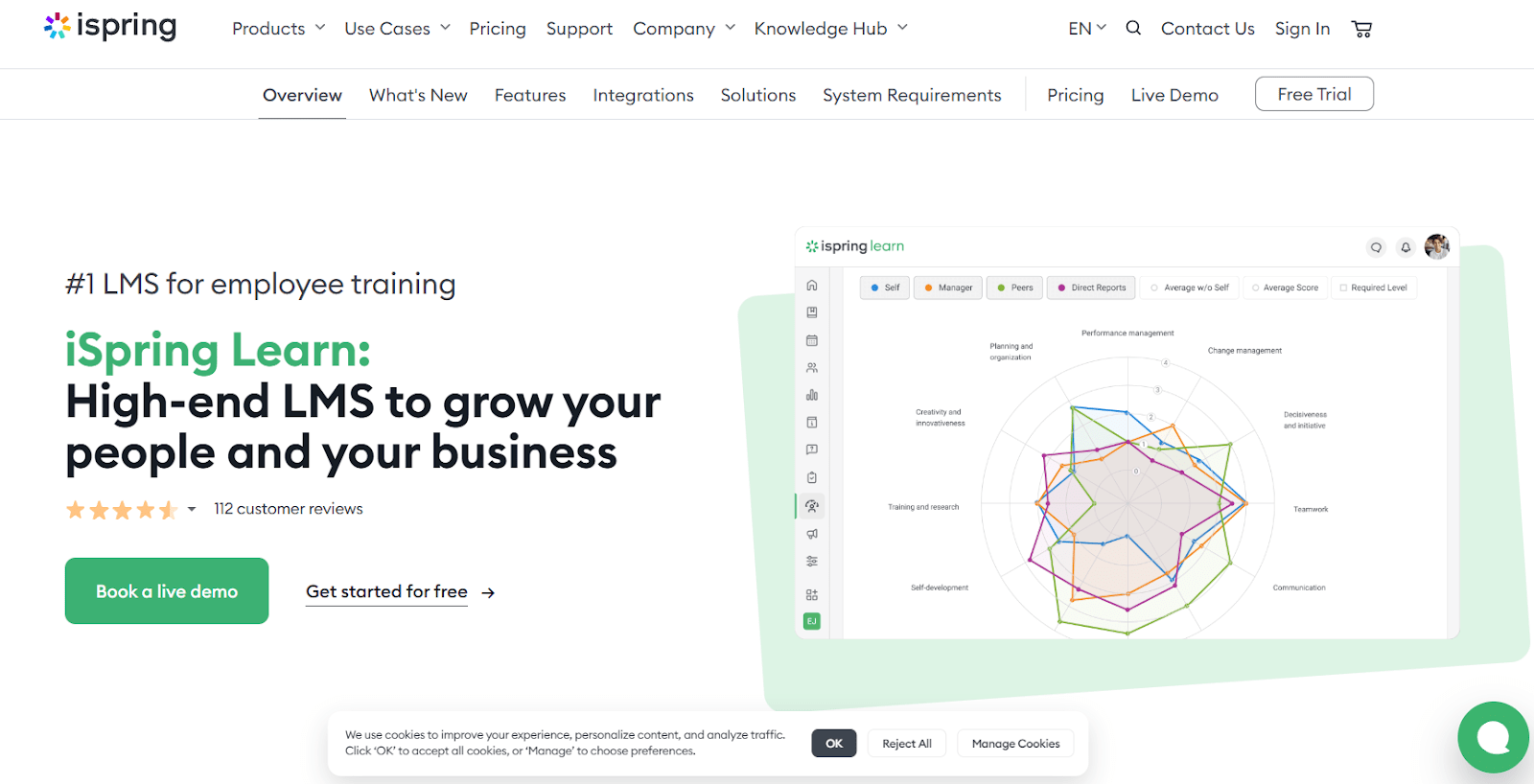
iSpring Learn operates as a cloud-based LMS designed to simplify content delivery, user management, and learning measurement. It supports uploading or creating content in formats such as SCORM, video, audio, PowerPoint, quizzes, and interactions.
Authors can also build training tracks or paths that enforce course order when needed. The platform provides mobile apps with offline access, role-based permissions, user grouping, and automated assignments to streamline training workflows.
Key features
- Personalized learning paths: Create structured learning tracks for specific user groups or departments and enable learners to self-enroll in relevant courses.
- Automated course enrollment and reminders: Set rules to automatically assign or reassign courses, notify learners about deadlines, new tasks, and upcoming events without manual follow-ups.
- Course and content creation tools: Convert slides into online courses, create video tutorials or screencasts, and develop role-play scenarios to build interactive learning content.
Pricing
iSpring Learn provides a 30-day free trial, and the following are the pricing plans the platform has for businesses.
- iSpring Suite: $970 per author/year
- iSpring Suite Max: $1290 per author/year
- iSpring Cloud: $720 per author/year

Wrapping up
Choosing the right LMS for customer training depends on aligning the platform with your organization’s unique needs; whether that means scalability for growing audiences, simplicity for ease of use, breadth of features, integration with your existing tools, or staying within budget.
We built FreshLearn to provide creators and small businesses with a simple yet powerful way to deliver customer training. Think it’s the right fit? Start free and experience how it can transform your training.
FAQ
1. What is the main difference between an employee LMS and a customer LMS?
An employee LMS focuses on internal training needs, such as onboarding, compliance, and professional development. A customer LMS delivers product education, onboarding, and support resources to external audiences. It can include customers, partners, or resellers, often emphasizing ease of access, branding, and scalability.
2. How long does it take to set up a customer training program?
The setup time depends on factors like the number of courses, integrations, and customizations needed. Teams typically upload content, configure learning paths, and set up user groups within a few days to a few weeks. It also depends on the LMS platform’s complexity and available resources.
3. How do you measure the ROI of customer training?
You measure ROI by tracking metrics such as course completion rates, product adoption levels, customer support tickets, churn reduction, and upsell or cross-sell revenue. Comparing these metrics before and after training helps determine its business impact.

